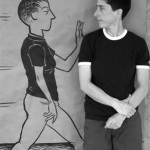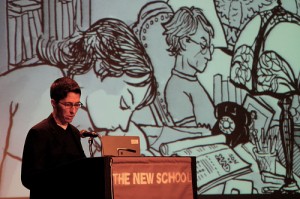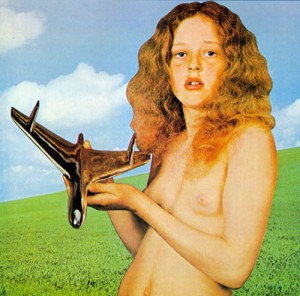 Fun House is my favorite book by far this year. As many blogs have mentioned, each chapter was like going to the library to read the work of a favorite author.
Fun House is my favorite book by far this year. As many blogs have mentioned, each chapter was like going to the library to read the work of a favorite author.
The illustrations are drawn with a friendly touch and the dual combination panels are hilarious (35, when “the family business” is mentioned as the father looks down indifferently to talk with a gravedigger, the two older children R.I.P. laying down on the ground behind a tombstone, one of them holding a flower).
What I most appreciated was the way Bechdel opened up her private memories and put them into a publically accessible format.
I think in this way, she made sense of her life.
Although her wry witticisms and socially adept ability to put humbling circumstances in a bright yet detached light, her family life was seriously embedded with dysfunctional characters. I don’t want to focus on her limited explanations/excuses about her father not being understood because of his gender identity crisis. Bechdel explains early on that he was a manic-depressive. Her illustrations tell us of abuse.
Children who come from families with major emotional problems or addictions are damaged two ways, once when they live through the trauma of not knowing their parents’ moods from one moment to the next, and then again when they are trying to set up the parameters of their own adult lives. This is known as generational trauma.
I thought she beautifully explained her longing to be close to her father when playing airplane for the sheer physical contact, sneaking a kiss before bedtime and ending up kissing his hand, and treasuring his detached letters as he communicated not with her, but about her curriculum while she was away at school.
In a way, she lost her mother as well as her father because it was him she emulated subconsciously as a child. While looking into the bathroom mirror Bechdel’s mother tries to show her how she would look with long hair pulled into a ponytail (116). This, of course is the way her mother wears her hair. There is no identity or modeling in this panel. Bechdel simply wines “MOMMM!”
As I said in the beginning, I also admired Bechdel’s illustrations, something she calls comics. In these, the words bubbles allow her to be a metatextual narrator. Both the illustrations and text come from a 1st person, limited POV.
Since her drawing process using tracings, I thought I might list some of the many steps Bechdel uses to come up with graphics:

- Draws panel outline or storyboard
- Using a digital camera and tripod, takes pictures of herself in poses she thinks she might use for herself, family members, and characters
- Scan these photos into Adobe Illustrator
- Using plain paper, sketches outline of panel
- Layer tracing paper over page and add detail
- Layer again with tracing paper, adding more detail each time, doing visual research to authenticate scenes -(1976 Google image search of her rooftop)
- Draw a pencil sketch of the panel
- Ink the drawing
- Erase the pencil marks
- Scan into Photoshop (using mouse clicks to blacken large areas (fireworks background)
- Shade with watered-down ink
- Scan above into Photoshop
- Combine those two drawings and shade again
- Click word panels into place on the computer
- Combine illustrations and text
http://www.mindtv.org/styles/mind/www/index.html Alison Bechdel – Creating “Fun Home: A Family Tragicomic”Fun

